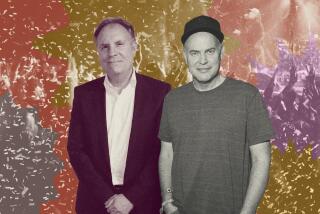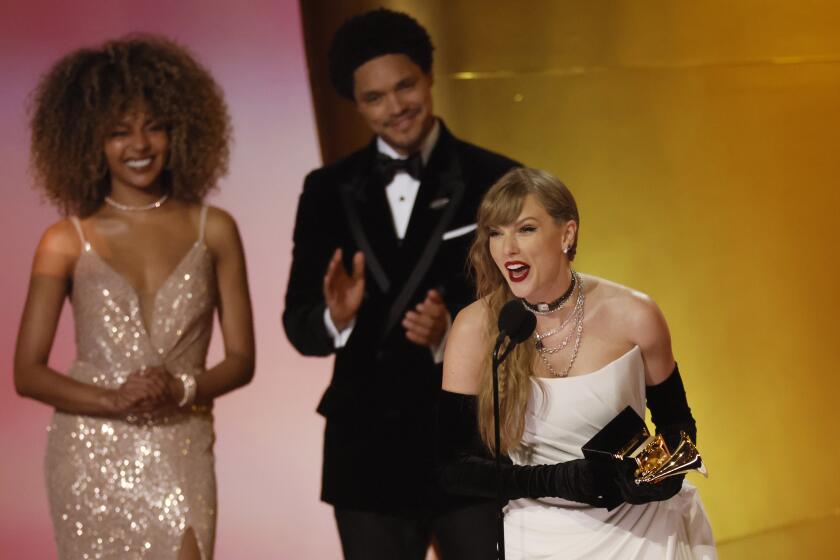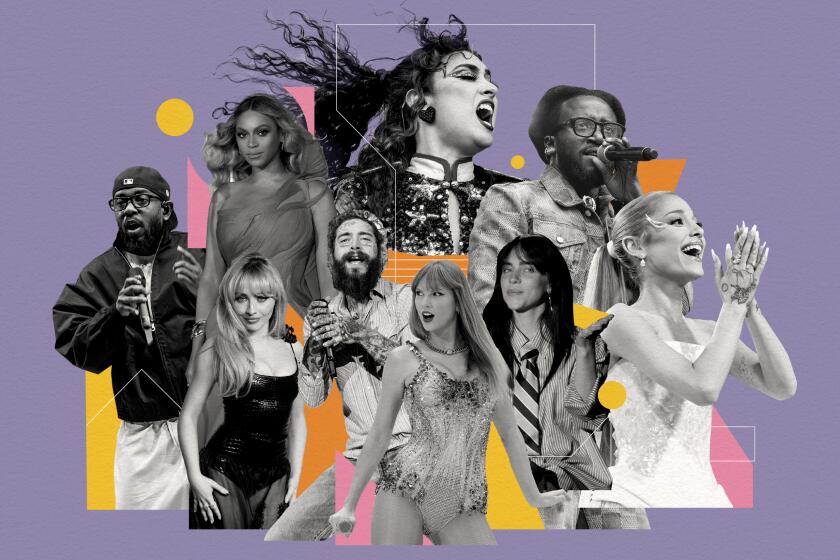If You Build It, Will They Come?
- Share via
INDIO — The vast plain of grass, meticulously kept and vibrantly green, contrasts sharply with the dusty, craggy mountains that surround it. Winding paths, horse statues and other country-club trappings give the Empire Polo Field the feel of a plush oasis in this hardscrabble town. But look closely at the site and you also notice mounds of horse droppings drying under the desert sun.
That’s fitting. This lush 78-acre venue is the field of dreams for the organizers of the first Coachella Valley Music and Arts Festival, but the promoters of the ambitious concert being staged Saturday and Sunday also know there are plenty of potential land mines.
“For Southern California, this could be the start of something really special,” said Paul Tollett, one of the owners of Goldenvoice, the promoters for the show, which features Beck, Rage Against the Machine, Tool, Moby and more than 50 other acts, including a deep roster of electronic music artists.
The Coachella Festival, two years in the making, might be just as easily called the Great Experiment in the Desert.
The show is a daring attempt by Tollett and his partners to import the European concept of a multi-day non-touring festival to Southern California, where they hope to create an annual tradition that would be unique in the U.S.
There are music festivals anchored to street fairs in urban centers, such as Bumbershoot in Seattle, as well as all-star touring shows, such as Lilith Fair and Lollapalooza. But Coachella would seem to offer a different experience.
With its remote site and eye toward a larger regional draw, Coachella taps into the European festival model. Two stages and three tents also will feature a bevy of artists who were picked more for their critical acclaim than for commercial success.
“I can’t think of any real parallels to this,” says Gary Bongiovanni, editor in chief of Pollstar, the concert industry trade magazine. “There aren’t any Glastonbury or Reading festivals in the U.S., so this would be something different for the people of Los Angeles.”
For Los Angeles and well beyond, according to Ticketmaster sales records, which indicate that fans in 42 states have bought tickets for the event and that one in 10 sales was made outside Southern California.
Still, there are challenges facing the event, from the distance from Los Angeles (about a two-hour drive) to the $50 per-day ticket price. The harshest challenge, though, may be a case of unfortunate timing: Tickets for Coachella went on a sale a week after Woodstock 99 went up in flames.
“We took a beating after Woodstock,” Tollett said last week as he toured the Indio site. “It was the obvious question for people to raise, but our event is so different that the comparison is just . . . well, it’s just not a good one.”
The looting and arson at Woodstock 99 were blamed by many on the dehumanizing conditions at the former Air Force base in upstate New York. Prices for food and water were high, portable toilets overflowed and aggressive metal and rock-rap acts dominated the bill. Coachella is the first major multi-day U.S. festival since that July mega-festival.
The Woodstock debacle may or may not have scared away some Coachella sales, but it clearly defined the early press for the event and led directly to a 40% jump in the Indio show’s insurance costs, Tollett said. In the desert city, community members have also expressed concerns about the event because of comparisons to Woodstock and to raves, the quasi-underground all-night dance parties that also feature electronic dance music.
“This isn’t Woodstock, this isn’t a rave. . . . It’s a whole different animal,” says Bob Puetz, the general manager of the Empire Polo Field. “Some [local residents] have still been concerned, but as they’ve found out more about it, they seem to understand.”
Indeed, even a casual observer could see that Coachella is markedly different from Woodstock on many other fronts. A sellout crowd for Coachella would bring 35,000 people a day to the site, far fewer than Woodstock’s crowd of 250,000. There will be no overnight camping at the venue (there are campgrounds nearby) and the show is scheduled to end at 11 p.m. both days. As of Monday, about 32,000 tickets for both days had been sold, but promoters were expecting a strong last week of sales.
Planners Emphasize Creature Comforts
The biggest difference, promoters say, may be the environment. The Goldenvoice promoters already had decided to make Coachella a model for a “high-comfort festival experience,” and they redoubled those efforts after seeing the images from Woodstock 99.
Advertisements for the show seem to devote as much ink to creature comforts as to the music lineup: “There will be plenty of drinking fountains available to guests for free. . . . We are going to provide a higher ratio of restroom facilities than any other festival. . . . All bathroom facilities will be cleaned throughout the day. . . . We are also providing mist tents to cool off in.”
Tollett and his partners worked in the past with the Lollapalooza tours and other outdoor shows, and they sensed a growing weariness among post-teen music fans with the sometimes grueling festival experience. With Coachella, he said, they want to lure back the fans who have decided to pass on sprawling, open-air music events.
What will they find at the Coachella Festival? One main stage and a smaller second stage, and three large tents that will house a DJ rotation and rave-style special effects. Two huge hot-air balloons will give fans rides, and former Jane’s Addiction frontman and Lollapalooza co-founder Perry Farrell has designed an “oasis tent” that promises some intriguing sights. The show starts at 1 p.m. both days, with gates open at noon, and though there will be overlap, the acts across the site will be staggered somewhat to give fans a chance to catch portions of different sets.
The inspiration for the event came when Tollett and his colleagues were traveling in Europe several years ago and became infatuated with the communal vibe and envelope-pushing music they encountered at the huge Glastonbury Festival in England and others they attended.
Since then, the Goldenvoice contingent has tried to create a similar event at the Indio venue, which Tollett calls “a special, special place.” The site is far different from most venues. Tall hedges and palm trees line a vast grass field that could handle a crowd of more than 85,000, though the daily ticket pool is less than half that.
“We don’t want people to feel like they’re on top of each other,” Tollett said. “They’ll be surprised when they get here how much space there is.”
This is only the second major music event at the Polo Field, which hosted a Pearl Jam concert organized by Goldenvoice in 1993. Fans who attended that show were trapped in a memorable traffic snarl as Indio’s small streets were overwhelmed and parking fee collections slowed the flow into the venue’s lots. To ease those problems, there will be no parking fee for this event, and Goldenvoice brought in a traffic planner who has worked with the Los Angeles Marathon.
The sound of Coachella also is more focused than the wildly diverse bill at Woodstock, where Metallica, Willie Nelson, the Offspring and Jewel split stage time. Coachella, by contrast, has an emphasis on critics’ darlings, such as Beck and Rage Against the Machine, and electronic genre artists such as Moby, the Chemical Brothers and Underworld.
“We felt like missionaries at Woodstock,” joked Ed Simons, one-half of the Chemical Brothers. He expects a warmer welcome from electronic dance fans attracted to the Coachella show. “Woodstock did not seem like a celebration of music, it was just a show with the big bands of the day. The [Coachella] lineup is just incredible. Big names and some pretty obscure, cool dance acts.”
Obscure is not always good for a first-time festival. But Goldenvoice purposely pieced together a lineup that would look different from similar outdoor shows in the region, such as the annual KROQ-FM (106.7) Weenie Roast, which is the equivalent of an all-star game featuring the big-time alt-rock album sellers for the given year.
The Coachella organizers say they politely turned down some “name” bands that could have pumped up the marquee value but would have clashed with the cutting-edge sensibility. The bill also has an unusually large number of artists who don’t have new releases out, another nod to the goal of assembling a show highlighting art, not commerce.
To Englishman Simons, who has performed at Reading and other festivals, the notion of bringing the European model to the U.S. is intriguing. “In England we have them because you can get to things easier--America is so big, I can see why they don’t have them. We’ll see how this one goes.”
Others will be watching as well. Several out-of-state promoters are planning to attend to scope out the show’s viability, Tollett says. The success of the show could have a major impact on the fate of Goldenvoice, an independent promoter that carved out a solid niche with alternative rock bookings in the last decade and a half but has also watched the industry landscape shift to huge conglomerates that own venues.
The New York-based SFX has scooped up promoters and venues across the country. Add that to the House of Blues’ purchase of Universal Concerts, and Southern California is dominated by a pair of concert business titans. But Tollett says neither of those powerhouse companies would be interested in assembling big festivals (“That would take acts out of the amphitheaters they own,” he says), so the Coachella model may be a chance for Goldenvoice to create a special spot for itself. A failure, though, would wound the company.
“This show is a real crossroads for us,” Tollett concedes. “We wouldn’t go out of business if it doesn’t go well, but a success means we could take it up a notch, yes.”
No matter how successful, the show will not become a touring beast, he said. The event’s name purposely mentions the Coachella Valley to create a geographic anchor and, he hopes, a lasting impression in the minds of fans. “We are trying to make an event that people will remember the rest of their lives, quite honestly, and that’s not easy.”
BE THERE
Coachella Valley Music and Arts Festival 1999, Saturday and Sunday at Empire Polo Field, 81-800 Avenue 51, Indio. 1 p.m. $50. (323) 692-9361. Web site https://www.coachella.com.
(BEGIN TEXT OF INFOBOX / INFOGRAPHIC)
Festival Lineup
SATURDAY
Beck
The Chemical Brothers
Morrissey
Perry Farrell
Cornelius
Bis
Underworld
Art of Noise
Breakbeat Era with DJs Roni
Size, Die and Dynamite MC
Richie Hawtin
Juan Atkins
Kevin Saunderson
Derrick May
Spiritualized
Medeski, Martin & Wood
Modest Mouse
Super Furry Animals
Los Amigos Invisibles
IQU
At the Drive-In
The Bicycle Thief
Perfect Circle
Amon Tobin
Kid Koala
Jurassic 5
Mr. Scruff
Nightmares on Wax (DJ Ease)
DJ Food
u-Ziq
Tomas-Umoja Hifi
DJ Rap
The Wiseguys
Bassbin Twins (live)
Ming & FS
Christopher Lawrence
Simply Jeff
Mike Fix
*
SUNDAY
Rage Against the Machine
Tool
Ben Harper & the Innocent Criminals
Pavement
Cibo Matto
Money Mark
Moby
GusGus
Thievery Corporation (live)
Lamb
Esthero
Fantastic Plastic Machine
BT
Banco de Gaia
The Angel a.k.a. 60 Channels featuring Angie Hart, Tre Hardson, Navigator
DJ Shadow
Innerzone Orchestra featuring Carl Craig
Spearhead
Gil Scott-Heron
Rahzel
Ugly Duckling
Progression Sessions featuring LTJ Bukem, Blame & MC Conrad
Mix Master Mike
DJ Q-Bert
A-Trak
4Hero
DJ Cam
Scratch Perverts UK
Science Sessions featuring Raymond Roker, Jun, MC Question Mark
Lunatic Calm
DJ Carbo
Neotropic
Luke Vibert with BJ Cole
Autechre (DJ set)
Bola
Jega (live)
Andy Maddocks
Rob Hall
Mira Calix
Push Button Objects
Main Stage DJs: Kid Koala, Jason Bentley, Liquid Todd, Jun, Raymond Roker
More to Read
The biggest entertainment stories
Get our big stories about Hollywood, film, television, music, arts, culture and more right in your inbox as soon as they publish.
You may occasionally receive promotional content from the Los Angeles Times.










